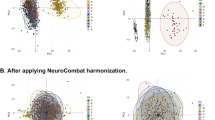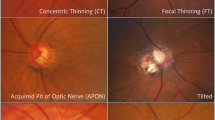Abstract
Background
Optic pathway gliomas (OPGs) are classified by anatomic location and the association with neurofibromatosis type 1 (NF1). Children with OPGs face sequelae related to tumor location and treatment modalities. We assessed the prevalence of endocrine dysfunction in children with OPGs and compared outcomes between those with and without NF1.
Methods
We performed a retrospective medical record review of medical history, and clinical and laboratory data, of children diagnosed with OPGs (n = 59, 61% with NF1) during 1990–2020, followed at a tertiary endocrine clinic. Growth and puberty parameters and occurrence of endocrine dysfunction were evaluated.
Results
Isolated optic nerve involvement was higher among patients with than without NF1. Patients without NF1 were younger at OPG diagnosis and more often treated with debulking surgery or chemotherapy. At the last endocrine evaluation, patients without NF1 had comparable height SDS, higher BMI SDS, and a higher rate of endocrine complications (78.3% vs. 41.7%, p = 0.006). Younger age at diagnosis, older age at last evaluation, and certain OPG locations were associated with increased endocrine disorder incidence.
Conclusions
Endocrine dysfunction was more common in patients without NF1; this may be related to younger age at presentation, tumor locations, a greater progressive rate, and more aggressive treatments.
Impact
-
The literature is sparse regarding sporadic OPGs, and the mean duration of follow-up is shorter than at our study.
-
Our data show a higher rate of endocrine dysfunction in patients with OPGs than previously described.
-
We also found a higher prevalence of endocrine dysfunctions among patients without compared to those with NF-1.
-
A better understanding of the true prevalence of endocrine disabilities that may evolve along time can help in guiding physicians in the surveillance needed in patients with OPG.
Similar content being viewed by others
Log in or create a free account to read this content
Gain free access to this article, as well as selected content from this journal and more on nature.com
or
Data availability
The datasets generated during and/or analyzed during the current study are not publicly available due to patients’ confidentiality but are available from the corresponding author on reasonable request.
References
Hill, C. S. et al. Neurosurgical experience of managing optic pathway gliomas. Childs Nerv. Syst. 37, 1917–1929 (2021).
Helfferich, J. et al. Neurofibromatosis type 1 associated low-grade gliomas: a comparison with sporadic low-grade gliomas. Crit. Rev. Oncol. Hematol. 104, 30–41 (2016).
Dodge, H. W. et al. Glioma of the optic nerves. Arch. Neurol. Psych. 79, 607–621 (1958).
Taylor, T. et al. Radiological classification of optic pathway gliomas: experience of a modified functional classification system. Br. J. Radiol. 81, 761 (2008).
Miller, D. T. et al. Health supervision for children with neurofibromatosis type 1. Pediatrics 143, 1–16 (2019).
Habiby, R., Silverman, B., Listernick, R. & Charrow, J. Precocious puberty in children with neurofibromatosis type 1. J. Pediatr. 126, 364 (1995).
Vassilopoulou-Sellin, R., Klein, M. J. & Slopis, J. K. Growth hormone deficiency in children with neurofibromatosis type 1 without suprasellar lesions. Pediatr. Neurol. 22, 355–358 (2000).
Grill, J. et al. When do children with optic pathway tumors need treatment? An oncological perspective in 106 patients treated in a single center. Eur. J. Pediatr. 159, 692–696 (2000).
Kortmann, R. D. et al. Current and future strategies in radiotherapy of childhood low-grade glioma of the brain. Part I: treatment modalities of radiation therapy. Strahlenther. Onko. 179, 509–520 (2003).
Thiagalingam, S., Flaherty, M., Billson, F. & North, K. Neurofibromatosis type 1 and optic pathway gliomas: follow-up of 54 patients. Ophthalmology 111, 568–577 (2004).
Listernick, R., Louis, D. N., Packer, R. J. & Gutmann, D. H. Optic pathway gliomas in children with neurofibromatosis 1: consensus statement from the NF1 Optic Pathway Glioma Task Force. Ann. Neurol. 41, 143–149 (1997).
Farazdaghia, M. K., Katowitza, W. R. & Averya, R. A. Current treatment of optic nerve gliomas. Curr. Opin. Ophthalmol. 30, 356–363 (2019).
Medlock, M. D. et al. Optic chiasm astrocytoma’s of childhood 1. Long-term follow-up. Pediatr. Neurosurg. 27, 121–128 (1997).
Binning, M. J., Liu, J. K., Kestle, J. R., Brockmeyer, D. L. & Walker, M. L. Optic pathway gliomas: a review. Neurosurg. Focus 23, 1–8 (2007).
Massimino, M. et al. High response rate to cisplatin/etoposide regimen in childhood low-grade glioma. J. Clin. Oncol. 20, 4209–4216 (2002).
Astrup, J. Natural history and clinical management of optic pathway glioma. Br. J. Neurosurg. 17, 327–335 (2003).
Tow, S. L., Chandela, S., Miller, N. R. & Avellino, A. M. Long-term outcome in children with gliomas of the anterior visual pathway. Pediatr. Neurol. 28, 262–270 (2003).
Rodriguez, L. A., Edwards, M. S. & Levin, V. A. Management of hypothalamic gliomas in children. An analysis of 33 cases. Neurosurgery 26, 242–247 (1990).
Attina, G. et al. Management of children with optic gliomas and neurofibromatosis type 1. Biomed. Pharmacol. J. 13, 1601–1606 (2020).
Miller, C., Guillaume, D., Dusenbery, K., Clark, H. B. & Moertel, C. Report of effective trametinib therapy in 2 children with progressive hypothalamic optic pathway pilocytic astrocytoma: documentation of volumetric response. J. Neurosurg. Pediatr. 19, 319–324 (2017).
Upadhyaya, S. A. et al. Marked functional recovery and imaging response of refractory optic pathway glioma to BRAFV600E inhibitor therapy: a report of two cases. Childs Nerv. Syst. 34, 605–610 (2018).
Sani, I. & Albanese, A. Endocrine long-term follow-up of children with neurofibromatosis type 1 and optic pathway glioma. Horm. Res. Paediatr. 87, 179–188 (2017).
Cambiaso, P. et al. Growth hormone excess in children with neurofibromatosis type-1 and optic glioma. Am. J. Med. Genet. A 173, 2353–2358 (2017).
Santoro, C. et al. Pretreatment endocrine disorders due to optic pathway gliomas in pediatric neurofibromatosis type 1: multicenter study. J. Clin. Endocrinol. Metab. 105, 2214–2221 (2020).
Martínez, R., Honegger, J., Fahlbusch, R. & Buchfelder, M. Endocrine findings in patients with optico-hypothalamic gliomas. Exp. Clin. Endocrinol. Diabetes 111, 162–167 (2003).
Marshall, W. A. & Tanner, J. M. Variations in the pattern of pubertal changes in boys. Arch. Dis. Child. 45, 12–23 (1970).
Marshall, W. A. & Tanner, J. M. Variations in the pattern of pubertal changes in girls. Arch. Dis. Child. 44, 291–303 (1969).
Kuczmarski, R. J., Ogden, C. L. & Grummer-Strawn, L. M. CDC growth charts: United States. Adv. Data 8, 1–27 (2000).
Styne, D. M. in Pediatric Endocrinology 2nd edn (ed. Sperling, M. A.) 599 (Elsevier Science, 2002).
Rosenfield, R. in Pediatric Endocrinology 2nd edn (ed. Sperling, M. A.) 494 (Elsevier Science, 2002).
Daniels, S. R. & Greer, F. R. Committee on Nutrition: lipid screening and cardiovascular health in childhood. Pediatrics 122, 198–208 (2008).
National Cholesterol Education Program (NCEP) Expert Panel on Detection, Evaluation, and Treatment of High Blood Cholesterol in Adults (Adult Treatment Panel III). Third Report of the National Cholesterol Education Program (NCEP) Expert Panel on Detection, Evaluation, and Treatment of High Blood Cholesterol in Adults (Adult Treatment Panel III) final report. Circulation 106, 3143–3421 (2002).
Parkhurst, E. & Abboy, S. Optic glioma in neurofibromatosis type 1. J. Pediatr. Ophthalmol. Strabismus 53, 334–338 (2016).
Jeuken, J. W. & Wesseling, P. MAPK pathway activation through BRAF gene fusion in pilocytic astrocytomas; a novel oncogenic fusion gene with diagnostic, prognostic, and therapeutic potential. J. Pathol. 222, 324–328 (2010).
Fouladi, M. et al. Survival and functional outcome of children with hypothalamic/chiasmatic tumors. Cancer 97, 1084–1092 (2003).
Collet-Solberg, P. F. et al. Endocrine outcome in long-term survivors of low-grade hypothalamic/chiasmatic glioma. Clin. Endocrinol. 47, 79–85 (1997).
Merchant, T. E., Conklin, H. M., Wu, S., Lustig, R. H. & Xiong, X. Late effects of conformal radiation therapy for pediatric patients with low-grade glioma: prospective evaluation of cognitive, endocrine, and hearing deficits. J. Clin. Oncol. 27, 3691–3697 (2009).
Gan, H. W. et al. Neuroendocrine morbidity after pediatric optic gliomas: A longitudinal analysis of 166 children over 30 years. J. Clin. Endocrinol. Metab. 100, 3787–3799 (2015).
Picariello, S. et al. A 40-year cohort study of evolving hypothalamic dysfunction in infants and young children (<3 years) with optic pathway gliomas. Cancers 14, 1–16 (2022).
Terashima, K. et al. Long term outcomes of centrally located low grade glioma in children. Cancer 119, 2630–2638 (2013).
Shalitin, S. et al. Endocrine outcome in long term survivors of childhood brain tumors. Horm. Res. Pediatr. 76, 113–122 (2011).
Listernick, R., Darling, C., Greenwald, M., Strauss, L. & Charrow, J. Optic pathway tumors in children: the effect of neurofibromatosis type 1 on clinical manifestations and natural history. J. Pediatr. 127, 718 (1995).
Lustig, R. H. et al. Risk factors for the development of obesity in children surviving brain tumors. J. Clin. Endocrinol. Metab. 88, 611–616 (2003).
Josefson, R. L., Listernick, B., Charrow, J. & Habiby, R. L. Growth hormone excess in children with optic pathway tumors is a transient phenomenon. Horm. Res. Pediatr. 86, 35–38 (2016).
Josefson, J., Listernick, R., Fangusaro, J. R., Charrow, J. & Habiby, R. Growth hormone excess in children with neurofibromatosis type 1-associated and sporadic optic pathway tumors. J. Pediatr. 158, 433–436 (2011).
Cambiaso, P. et al. Growth hormone excess in children with neurofibromatosis type-1 and optic glioma. Am. J. Med. Genet. 173A, 2353–2358 (2017).
Manski, T. J., Haworth, C. S., Duval-Arnould, B. J. & Rushing, E. J. Optic pathway glioma infiltrating into somatostatinergic pathways in a young boy with gigantism. Case report. J. Neurosurg. 81, 595–600 (1994).
Listernick, R., Charrow, J., Greenwald, M. J. & Esterly, N. B. Optic gliomas in children with neurofibromatosis type 1. J. Pediatr. 114, 788–792 (1989).
Stein, D. T. Southwestern Internal Medicine Conference. New developments in the diagnosis and treatment of sexual precocity. Am. J. Med. Sci. 303, 53–71 (1992).
Clementi, M. et al. Neurofibromatosis type 1 growth charts. Am. J. Med. Genet. 87, 317–323 (1999).
Szudek, J., Birch, P. & Friedman, J. M. Growth in North American white children with neurofibromatosis 1 (NF1). J. Med. Genet. 37, 933–938 (2000).
Gajjar, A. et al. Low-grade astrocytoma: a decade of experience at St. Jude Children’s Research Hospital. J. Clin. Oncol. 15, 2792–2799 (1997).
Fisher, P. G. et al. Outcome analysis of childhood low-grade astrocytomas. Pediatr. Blood Cancer 51, 245–250 (2008).
Stokland, T. et al. A multivariate analysis of factors determining tumor progression in childhood low-grade glioma: a population-based cohort study (CCLG CNS9702). Neuro. Oncol. 12, 1257–1268 (2010).
Funding
No financial assistance was received in support of the study.
Author information
Authors and Affiliations
Contributions
M.G.M.—substantial contributions to acquisition of data, analysis and interpretation of data, drafting the article and revising it critically for important intellectual content, and final approval of the version to be published. M.Y.-G.—substantial contributions to analysis and interpretation of data, revising the article critically for important intellectual content, and final approval of the version to be published. H.T., A.T., R.C., and M.P.—substantial contributions to acquisition of data, revising the article critically for important intellectual content, and final approval of the version to be published. S.S.—substantial contributions to conception and design, acquisition of data, analysis and interpretation of data, drafting the article and revising it critically for important intellectual content, and final approval of the version to be published.
Corresponding author
Ethics declarations
Competing interests
The authors declare no competing interests.
Ethics approval and consent to participate
This study was approved by the local Institutional Review Board. Patient consent was not required.
Additional information
Publisher’s note Springer Nature remains neutral with regard to jurisdictional claims in published maps and institutional affiliations.
Rights and permissions
About this article
Cite this article
Gil Margolis, M., Yackobovitz-Gavan, M., Toledano, H. et al. Optic pathway glioma and endocrine disorders in patients with and without NF1. Pediatr Res 93, 233–241 (2023). https://doi.org/10.1038/s41390-022-02098-5
Received:
Revised:
Accepted:
Published:
Issue date:
DOI: https://doi.org/10.1038/s41390-022-02098-5
This article is cited by
-
MRI-based, three-dimensionally assessed tumor burden and growth velocity to predict visual acuity deterioration in optic pathway glioma — results of a retrospective longitudinal analysis
Child's Nervous System (2025)
-
Treatment evaluation by volumetric segmentation in pediatric optic pathway glioma: evaluation of the effect of bevacizumab on intra-tumor components
Journal of Neuro-Oncology (2024)



